

Food glorious food. Aside from a paying job, no other facet of daily life consumes so much time and energy. Trying to eat in a foreign place magnifies that effort, and I still don’t feel like I have a handle on eating in Beijing.
Certainly, I now have a much better perspective on how Chinese natives must feel trying to eat in the U.S. There are many varieties of food here: Cantonese food, Sichuan food, Hunan food, northeastern Chinese food, and lots more... Chinese food. The food court at the local mall has all of that, plus Japanese for variety. Actually, the mall’s food court includes a place that serves grilled steak — with, mysteriously, a fried egg on the side instead of potato. I imagine that a Chinese visitor to an American mall would be equally mystified by egg rolls and fortune cookies, as well as the absence of decent green vegetables.
Mall food courts aside, I think you can probably get any kind of food that you want in Beijing, as long as you spend enough money. Also, I’m starting to doubt that region-of-origin is the best way to classify food here. Nevertheless, let’s start with Chinese food.
As I mentioned earlier, the first food we ate on arrival was from a streetside restaurant stand, which is the equivalent of a drive-through for pedestrians. A family of four can easily eat for 8 yuan, which is about one U.S. dollar. Streetside stands are no way to eat all the time, of course; it would be like getting every meal from McDonald’s and Taco Bell drive-throughs. And, just as Taco Bell is about as diverse as drive-through food gets, streetside stands all sell about the same things, with Xinjiang (western China) lamb kabob as the outside-the-bun option. Most streetside food is seasoned with a tangy condiment whose name I don’t know; it has become known in our family as “ubiquitous brown sauce.”
 |  |
Next up the food chain is the xiaochi (literally “small eats”), which is a cheap cafe. My opinion of the xiaochi has improved in the last week, since we finally found some that we like. In retrospect, it should have been obvious that finding a good xiaochi would take a few tries. After all, we regularly eat at only a handful of the available cafes in Salt Lake.
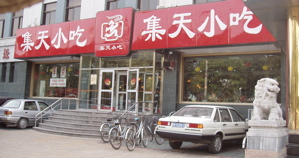 | 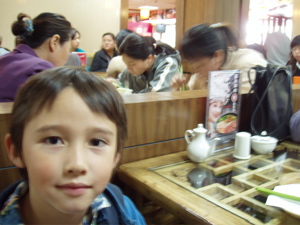 |
After the cafes are the restaurants with attentive waiters. And then there are the nice restaurants with tablecloths, cloth napkins, waitstaff who replace your plate when it has too many bones or shells, and food that is unfailingly delicious.
 | 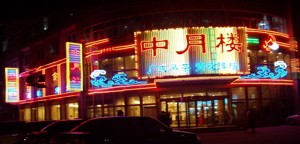 |
The relative prices at different types of restaurants are about what you’d expect, but the starting price and current exchange rate completely change the game, at least for our family. In the “nice restaurant” category, we usually spend less than $15. If a $15 dollar meal at Wendy’s is a small cost to your family, but a $150 dollar meal downtown is a special occasion, then imagine that the $150 meal becomes as affordable as Wendy’s. It changes the way that you think about dinner.
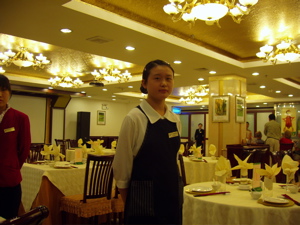 |  |
There are certainly more expensive restaurants, and there are plenty of people who can afford to eat at them. So far, my experience with more expensive dining has been mostly in the area of non-Chinese food.
Eating at Gino Cafe (a chain of Italian restaurants) is more expensive than a nice Cantonese restaurant, although the food is not as good. Pizza Hut is on a similar level, and it’s really Pizza Hut. The Thai restaurant we tried had prices approaching what we pay in Salt Lake, and the food was not quite as good.
In short, when you venture outside of the realm of Chinese food, the quality-to-price ratio drops quickly. This is a simple matter of supply and demand. Beijing is big and cosmopolitan enough to support some demand for non-Chinese food, while the supply of Chinese food is endless. And even though the local Cantonese restaurant has better food (to my taste) on some absolute scale, I expect to return to Gino Cafe once in a while to get pasta with cheese. I’m used to better Italian, so it feels like Beijing has relatively little variety of food, but I think that just means I need to look harder for things that I’m used to.
As a case in point, consider the humble loaf of bread. After two months in Beijing, I still have trouble finding bread that I like. Grocery stores sell a lot of “American-style” bread. It’s like Wonder bread, but usually sweeter and even spongier. The variety with corn mixed in seems popular. Wal-Mart has a large selection of white breads, all with a three-raisin minimum. Carrefour sells a standard industrial baguette, if you ignore the strip of salt on the top. Tous Les Jours sells baguettes pre-sliced with slabs of cream (butter?) installed between the slices, or with any number of salty toppings, but not plain, as far as I can tell. Whole wheat bread is easier to find; I guess the visible grains make it acceptable without further modification to Chinese taste. None of those are quite what I’m looking for, but I expect I’ll eventually find a supply of bread.
Finding American fast food is easy. We have not yet strayed into a McDonald’s, but I can report that in some other American outposts, the food and prices (relative to dollars, as opposed to local food) are very similar to home. I was surprised to find that Subway is popular, and that the sandwiches are exactly as always. I was not surprised to find that KFC is especially popular, since fried chicken is a good match to the local taste. Pizza Hut is also well established, but it’s a sit-down restaurant with waiters who, when asked whether a pizza can be half Supreme and half cheese, dutifully consult the chef and return to report that, regretfully, the request cannot be accommodated.1
With those options, we generally eat at Chinese restauraunts. More specifically, we concentrate on Cantonese restauraunts, which is Wen’s preference. Cantonese was apparently all the rage in Beijing a few years ago; Sichuan and other varieties have since gained an equal foothold, but that leaves plenty of options for us. Wen is extremely happy with the food here — near enough to Canton to be nearly food heaven.
 | 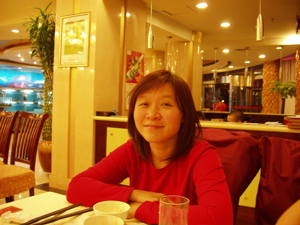 |
Chinese restaurants are organized into chains far more than I remember seeing before. Most restaurants are still one-of-a-kind, I think, but many are now part of a small chain. Chengdu Xiaochi is everywhere. Even the famous Quanjude has several branches downtown.
Quanjude brings us to Peking duck, which is a category on its own, because it doesn’t seem like Chinese food to me at all.2 Many nearby restaurants specialize in Peking duck at more reasonable prices than Quanjude, and so far, we’ve averaged one Peking duck every two weeks. Now that I think about it, I’m surprised that Peking duck hasn’t caught on in the U.S. It has the key characteristics of popular American food: it’s meat wrapped with bread, and there’s a relative absence of vegetables. I suppose you could add cheese, or certainly bacon. Market it as Chinese Duck Fajitas, and Americans will catch on fast.
What about eating at home? We tried it at first. After we noticed the economy of dining out, we started eating at home less and less. Besides, the ingredients that we normally use for cooking are difficult to find here. Wen is an especially good cook, but even she developed her skills using American ingredients.
 |
Thus, our kitchen holds little more than snacks and breakfast food, sustained in part by a daily milk delivery (one small bag) and a bi-weekly yogurt delivery (one small bottle). I doubt that we’ll continue this way all year, though, because even eating out becomes a chore after a while. Also, we haven’t forgotten that one of our best meals in Beijing was a home-cooked dinner at a friend’s house.
| 1 | I exaggerate a bit. Chinese is not the sort of language where you say things like “regretfully, your request cannot be accommodated.” It’s just “no, not ok,” even in a fancy place. |
| 2 | The brown sauce served with Peking duck is similar to hoisen sauce, not ubiquitous brown sauce. Fortunately. |
| Prev: People and Places | Contents: A Year in China: 2006-2007 | Next: Learning the Language |